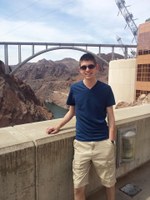Schreyer Scholar investigates climate science, oceanography through NOAA program

Image: Penn State
Ryan Creedon, a senior pursuing a bachelor’s degree in mathematics and both a bachelor’s and a master’s degree in meteorology, spent his summer working with the National Oceanic and Atmospheric Administration as part of the Ernest F. Hollings Scholarship Program.
While pursuing two bachelor’s degrees and one master’s degree concurrently, Penn State student Ryan Creedon has found numerous ways to get closer to his dream of becoming a professor.
Creedon is a Schreyer Scholar and a senior pursuing a bachelor’s degree in mathematics and both a bachelor’s and a master’s degree in meteorology through the Department of Meteorology’s integrated undergraduate-graduate (IUG) program. This past summer, he was accepted into the National Oceanic and Atmospheric Administration (NOAA) Ernest F. Hollings Scholarship Program. He is utilizing what he learned through his summer internship to bolster his academics at Penn State.
The NOAA Hollings Scholarship Program annually accepts and mentors approximately 100 summer interns in the earth sciences and educates them about careers and research opportunities with NOAA.
Creedon first discovered the program as a sophomore and, after researching it, he found he would be able to apply his passions for weather and science.
“The scholars program is a great experience for students from countless academic backgrounds, especially earth science students. It’s also really good for students interested in conducting research,” said Creedon.
An in-depth experience
Students in the summer program complete a ten-week internship at a NOAA facility of their choice. The internship culminates in a symposium in Washington, D.C. where the students present their internship research.
Students choose a mentor based on their area of interest. Creedon chose to work with Meghan Cronin, an oceanographer at NOAA’s Pacific Marine Environmental Laboratory in Seattle. There, Creedon investigated ocean turbulence in the north Pacific Ocean. He also examined the ocean’s heat, salt and carbon budgets to look at the effects of climate change.
“I spent most of my summer analyzing data from the north Pacific Ocean and comparing these data to results derive from a turbulence model. My primary research question was to understand why upper-ocean turbulence can vary across seasons and ocean basins.”
Creedon supplemented his experience by meeting with and talking to faculty members at the nearby University of Washington as well.
“When I visited the university, I met peers doing similar work in oceanography and applied mathematics. They also let me take a quick tour of their fluid dynamics lab, which was pretty neat,” said Creedon.
Inspired by his summer research, Creedon decided to incorporate what he learned into his Penn State research projects.
As a member of the Schreyer Honors College and the IUG program, he is required to complete both an undergraduate honors thesis, as well as a master’s thesis.
Since completing his summer internship, Creedon has been working with Cronin, as well as he his thesis adviser, Raymond Najjar, professor of oceanography at Penn State.
Building strong science communication skills
One takeaway from his summer research experience was the opportunity to build better scientific communication skills when interacting with the public.
“NOAA plans its goals around building effective communication between scientists and researchers, and the public. I agree with that vision, and this program has really let me work on my professional development while pursuing my passions for mathematics and meteorology,” Creedon said.
The fact that NOAA is focusing its research efforts on climate change communication is crucial for the future.
“NOAA is revamping their system to try to reach more people and explain to them what climate change is and how they can help with the issues it causes. The NOAA Hollings symposium is a way to address a critical need to build good communicators for both NOAA and climate change,” said Creedon.
As part of the NOAA Hollings program, students can receive funding to present the research from their summer internships at national conferences to continue building their scientific communication skills. Creedon plans to present his research at both the American Meteorological Society’s Annual Meeting and the American Geophysical Union’s Ocean Sciences Meeting.
Because the experience helped him develop so much, Creedon has focused some of his senior-year efforts on informing first- and second-year earth science students about the program.
“Working alongside leading NOAA scientists is a tremendous honor in and of itself. They stressed humbleness and how to act responsibly alongside the educational work. For that experience alone, I’m extremely grateful. But, I’m also equally grateful for the opportunity to develop professionally and take another step closer to my future in academia,” said Creedon.

